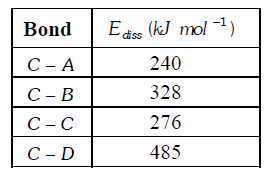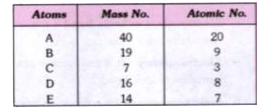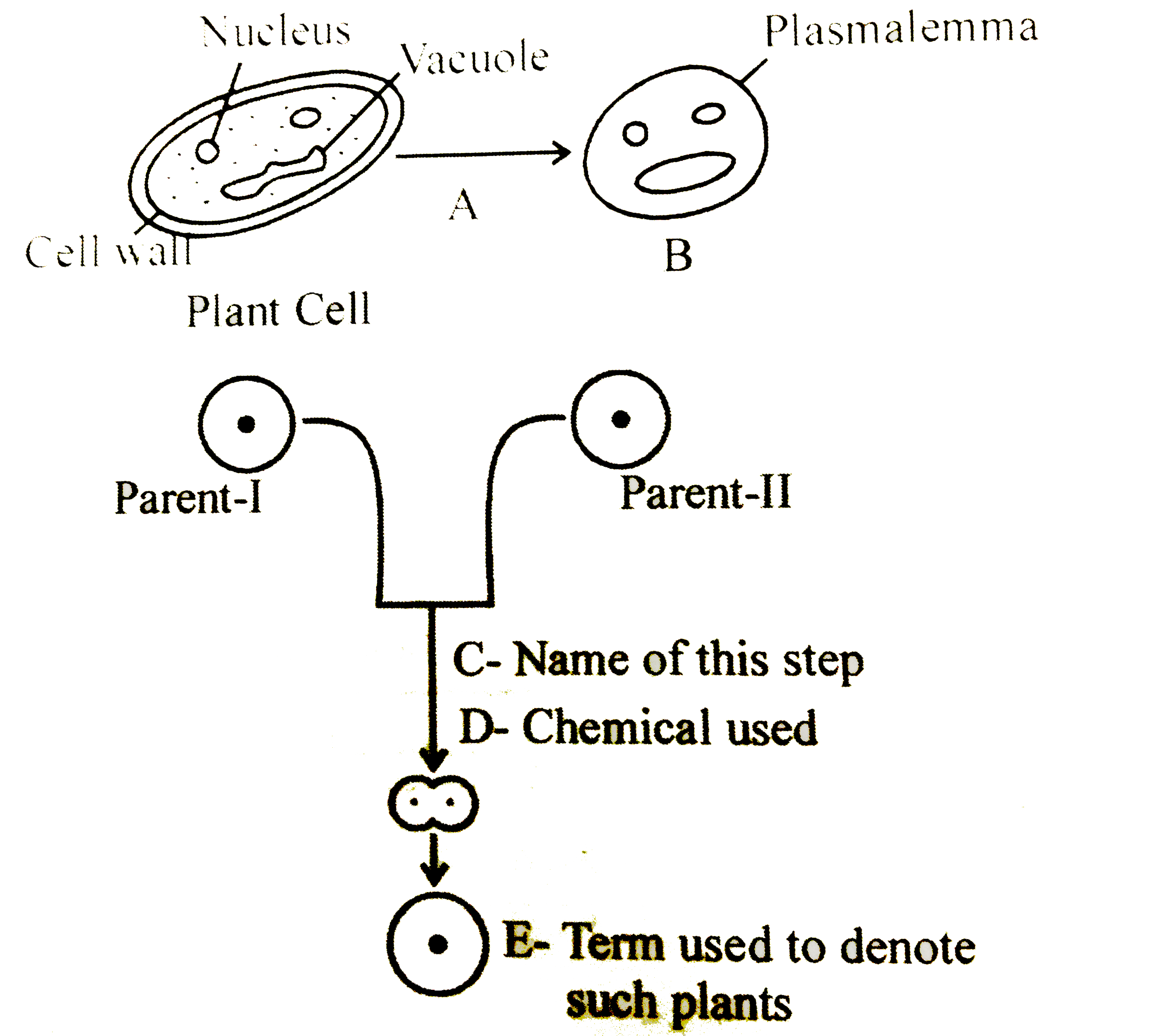The table given below lists the bound dissociation energy (Ediss) for single covalent bonds formed between C and atom A,B,D,E.
What of the atoms has smallest size?
D
E
A
B
To determine which atom has the smallest size based on the bond dissociation energy (E_diss) for the covalent bonds formed with carbon, we can follow these steps:
1. Understand Bond Dissociation Energy:
Bond dissociation energy is the energy required to break a bond between two atoms. A higher bond dissociation energy indicates a stronger bond, which typically correlates with smaller atomic size.
2. Analyze the Relationship Between Atomic Size and Bond Energy:
The strength of a bond is influenced by the size of the atoms involved. Smaller atoms can get closer together, leading to stronger attractive forces between their nuclei and the shared electrons. Thus, the bond will be stronger, resulting in higher bond dissociation energy.
3. Review the Given Data:
Look at the bond dissociation energies provided in the table for the bonds between carbon and atoms A, B, D, and E. Identify which bond has the highest dissociation energy.
4. Identify the Atom with the Highest Bond Dissociation Energy:
From the table, find the bond with the maximum dissociation energy. Let's assume that the bond between carbon and atom E has the highest dissociation energy.
5. Conclude the Size of the Atoms:
Since the bond between carbon and atom E has the highest bond dissociation energy, we can conclude that atom E must be the smallest in size among the given atoms A, B, D, and E.
Final Answer:
The atom with the smallest size is E.
---
Bond dissociation energy is the energy required to break a bond between two atoms. A higher bond dissociation energy indicates a stronger bond, which typically correlates with smaller atomic size.
The strength of a bond is influenced by the size of the atoms involved. Smaller atoms can get closer together, leading to stronger attractive forces between their nuclei and the shared electrons. Thus, the bond will be stronger, resulting in higher bond dissociation energy.
Look at the bond dissociation energies provided in the table for the bonds between carbon and atoms A, B, D, and E. Identify which bond has the highest dissociation energy.
From the table, find the bond with the maximum dissociation energy. Let's assume that the bond between carbon and atom E has the highest dissociation energy.
Since the bond between carbon and atom E has the highest bond dissociation energy, we can conclude that atom E must be the smallest in size among the given atoms A, B, D, and E.
The atom with the smallest size is E.
Topper's Solved these Questions
- THERMODYNAMICSBOOK - CENGAGE CHEMISTRY ENGLISHCHAPTER - THERMODYNAMICSEXERCISE - Exercise
1 Videos
- THERMODYNAMICSBOOK - CENGAGE CHEMISTRY ENGLISHCHAPTER - THERMODYNAMICSEXERCISE - Ex 6.1
26 Videos
- STOICHIOMETRYBOOK - CENGAGE CHEMISTRY ENGLISHCHAPTER - STOICHIOMETRYEXERCISE - Archives Subjective
33 Videos
Similar Questions
The table given below lists the bond dissociation energy (Ediss) for single covalent bonds formed between C and atoms A, B, D, E.
BondEdiss(kcal mol−1)C−A 240C−B 382C−D 276C−E 486
Which of the atoms has smallest size ?
View SolutionThe table shown below gives the bond dissociation energies (Ediss) for single covalent bonds of carbon (C ) atom with element A,B,c and D. Which element out of these has the smallest atoms ?

View SolutionIn the table given below, six elements are shown with their atomic numbers given in parenthesis.

Number of shells in atom E.
View SolutionFive atoms are labelled from A to E

Write down the formula of the compound formed between C and D.
View SolutionIn the table given below, six elements are shown with their atomic numbers given in parenthesis.

Among elements A, B, C, which one has largest atomic size.
View SolutionWhat happens to the potential energy of the system when two atoms form a covalent bond?
View SolutionGiven below is the process of somatic hybridisation indentify A, B, C, D and E.

View SolutionBond energies can be obtained by using the following relation: ΔH(reaction)=∑Bond energy of bonds, broken in the reactants −∑ Bond energy fo bonds, formed in the products
Bond enegry depends on three factors:
a. Greater is the bond length, lesser is the bond enegry.
b. Bond energy increases with the bond multiplicity.
c. Bond enegry increases with electronegativity difference between the bonding atoms.
The heat of formation of NO from its elements is +90kJmol−1, What is the approximate bond dissociation enegry of the bond in NO?
BEN=N=941kJmol−1BEO=O=499kJmol−1
View SolutionBond energies can be obtained by using the following relation: ΔH(reaction)=∑Bond energy of bonds, broken in the reactants −∑ Bond energy fo bonds, formed in the products
Bond enegry depends on three factors:
a. Greater is the bond length, lesser is the bond enegry.
b. Bond energy increases with the bond multiplicity.
c. Bond enegry increases with electronegativity difference between the bonding atoms.
Which among the following sequences is correct about the bond enegry of C−C,C=C and C≡C bonds?
View SolutionGive reasons for the following:
Molecules of hydrogen and chlorine have single covalent bonds between their atoms while oxygen has a double covalent and nitrogen a triple covalent bond respectively.
View Solution
